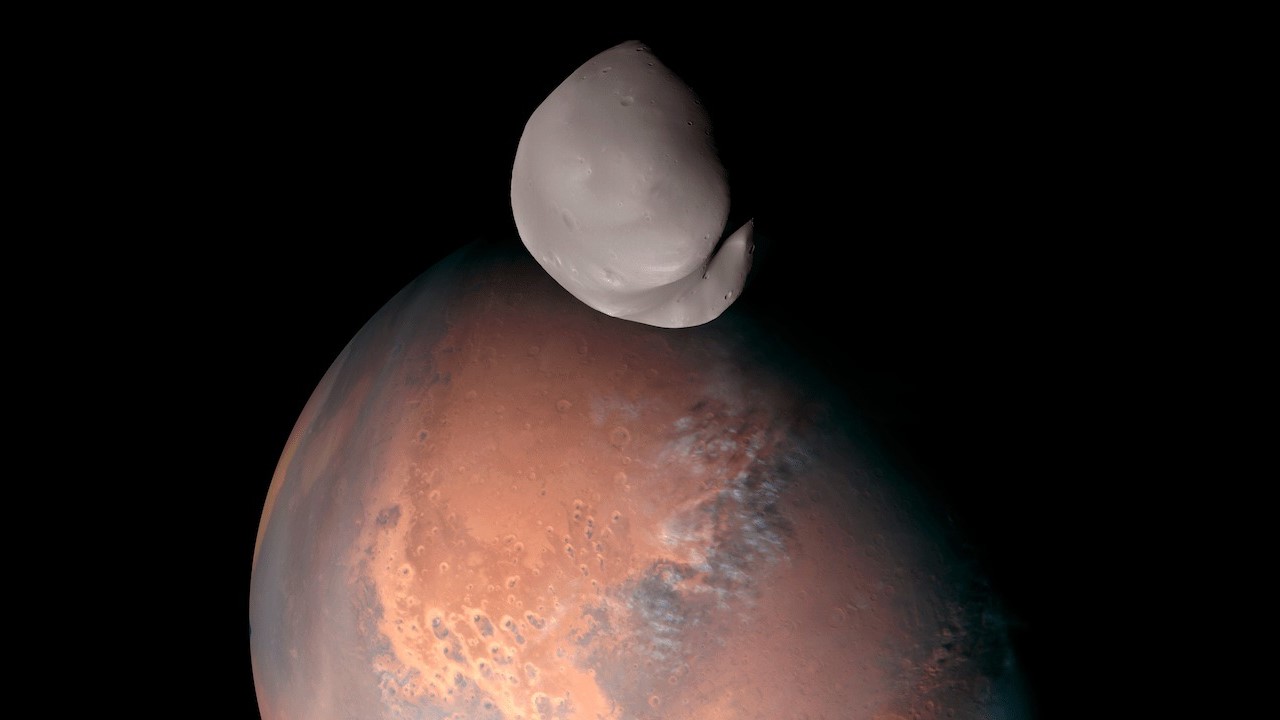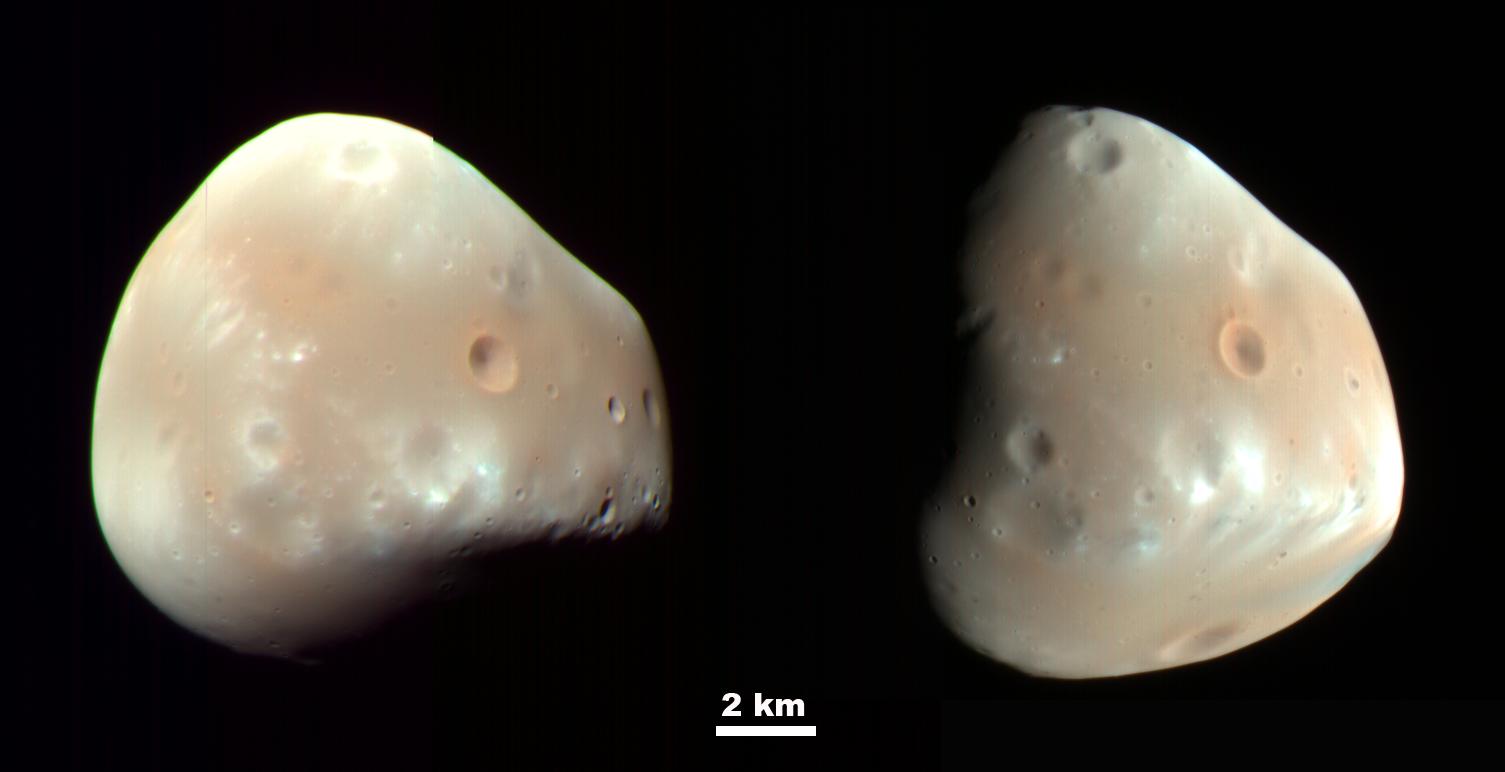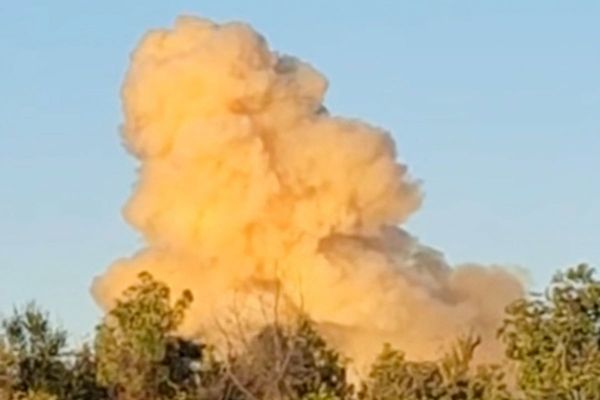
Deimos is Mars' outer moon. It's a tiny, irregularly shaped moon and smaller than Mars' other moon, Phobos. Despite being unspectacular, Deimos remains a fascinating mystery.
Deimos FAQs
What is special about the moon Deimos?
Deimos is one of only three moons in the inner solar system, and its origins are uncertain, meaning it still holds many secrets.
Is Deimos a doomed moon?
Deimos and its sibling moon Phobos have different fates. Phobos is spiraling toward Mars and will either break up and form a ring around the Red Planet or crash into the surface. Deimos, on the other hand, is spiraling away from Mars and could one day escape its gravity to go wandering through space by itself.
Where did the moon Deimos get its name?
The name "Mars" is the Latinized (Roman) version of the Greek god Ares, the god of war. In Greek mythology, Deimos and Phobos were Ares' sons, who would accompany him onto the battlefield. Deimos' name means "terror" or "dread."
Discovery of the moon Deimos
Moons are rare in the inner solar system. Neither Mercury nor Venus has a moon, and Earth, of course, has just one permanent natural satellite (though it sometimes captures temporary "minimoons"). Nobody knew of any moons orbiting Mars, either, until August 1877.
At that time, astronomer Asaph Hall was a professor at the U.S. Naval Observatory in Washington, D.C. He was in charge of the great 26-inch-aperture (660 mm) telescope there, which, at the time, was the largest refracting telescope in the world.
One of Hall's objectives was to use the telescope to search for moons orbiting Mars, but he knew that such a discovery would be difficult. He was about to give up, but his wife, Angeline Stickney, urged him to continue. His perseverance was rewarded on the night of Aug. 12, 1877, when he discovered Deimos. Hall kept looking, and on Aug. 18, 1877, he found Deimos' fellow moon, Phobos. (A large crater on Phobos is named Stickney, in honor of Hall's wife.)
Who is Deimos in Greek mythology?
Deimos and its fellow Martian moon Phobos are named after the mythological sons of Ares, the ancient Greek counterpart to Mars, the Roman god of war). Phobos means "fear," and Deimos means "dread." Fear, Dread and the God of War — they're certainly a fearsome combination. Homer's "Iliad" describes how Ares and his two sons would sow chaos and disorder in battle, with Deimos representing the dread felt by soldiers as they faced death.
How big is Deimos compared with Earth's moon?
Deimos is very small, measuring just 9.3 by 7.4 by 6.8 miles (15 x 12 x 11 kilometers). Compared with Earth's moon, which has a diameter of 2,159 miles (3,475 km), Deimos is just a tiny speck. In fact, Deimos could fit inside some lunar craters. Deimos' small size is partly why it was so difficult for Hall to find, even with the 26-inch refractor. The other reason was that it orbits very close to Mars, so it's often caught in the planet's glare.
How old is Deimos?

The age of Deimos really depends on how it formed, which we still don't know for sure. However, there are several theories.
It is undeniable that both Deimos and its fellow moon Phobos look very much like asteroids, and the asteroid belt is sandwiched between Mars and Jupiter. One theory is that Deimos and Phobos are captured asteroids that wandered a little too close to the Red Planet and became snagged by its gravity. If they are, they would have formed near the dawn of the solar system, about 4.6 billion years ago.
One problem with the captured-asteroid theory, however, is that the orbits of Deimos and Phobos are stable and nearly circular; captured objects tend to have more eccentric orbits, often orbiting retrograde or on a steep incline, such as Neptune's captured moon Triton. So perhaps Deimos and Phobos originated by some other means.
One theory that has gained traction in the past decade or so is that Deimos and Phobos formed much like Earth's moon did, coalescing out of debris from a mighty impact on the planet. An asteroid smacking into Mars could eject debris high above the Red Planet.
The theory certainly fits with the orbits of Deimos and Phobos, since the debris would settle into a ring around Mars' equator before accreting into moons, and both Deimos and Phobos orbit above Mars' equator. Phobos is the lower of the two moons, circling the Red Planet at an altitude of just 3,721 miles (5,989 kilometers), while Deimos is at a higher altitude of 12,470 miles (20,068 km). Intriguingly, in an exchange of orbital angular momentum, Phobos is slowly spiraling toward Mars, while Deimos is slowly spiraling away from Mars and could one day escape its gravity. Phobos, by contrast, is doomed to crash into Mars in about 50 million years.
If Deimos and Phobos formed from debris resulting from an asteroid collision on Mars, they must be younger than the Red Planet, which is 4.5 billion years old, but by how much is still unclear.
The most recent theory combines the previous two theories. It describes how Deimos and Phobos may have formed when a larger asteroid got too close to Mars, crossing what's called its Roche limit. This is the distance from Mars inside which gravitational tidal forces from the planet become too great and tear apart any interloping body. The distance of the Roche limit varies depending on the mass of the asteroid. Sometime in the distant past, an asteroid could have passed too close to Mars and been torn apart.
A research team led by Jacob Kegerreis of NASA's Ames Research Center performed supercomputer simulations showing how the debris from an asteroid fractured in this way would grind itself into dust, forming rings around Mars out of which Phobos and Deimos could have formed. The theory is attractive because it describes the rings extending as far as Deimos' orbit, which would explain how Deimos formed farther from Mars than Phobos did. This model also means that Deimos and Phobos could be much younger than Mars.
Missions to Deimos

Historically, Mars' moons have been ignored by space missions. However, in March 2023, the Emirates Mars Mission, launched by the United Arab Emirates, made a close encounter of Deimos and took the best-ever high-resolution close-up images of the small moon.
Hopes for learning more about Deimos (and Phobos) currently lie with the Japan Aerospace Exploration Agency's Martian Moons Exploration mission, which is set to launch in 2026. The mission will explore both Deimos and Phobos closely. It will map them and analyze their surface composition with a NASA-built instrument called the Mars-moon Exploration with Gamma Rays and Neutrons and bring a sample of Phobos back to Earth for study. This sample could reveal much about the history and origin of the moons and show which of the three main theories about their formation, if any, are correct.
Additional resources
NASA's Mars Reconnaissance Orbiter is the space agency's leading spacecraft in orbit around the Red Planet and has imaged Deimos. You can learn more about it on this NASA page. The European Space Agency (ESA) also has a Mars orbiter, Mars Express, which has imaged Deimos' sibling, Phobos. Learn about this mission from ESA. Learn more about the Mars moon facts with these resources from NASA.
Bibliography
Deimos', NASA, https://science.nasa.gov/mars/moons/deimos/
'Asaph Hall', Monthly Notices of the Royal Astronomical Society, Vol 68, issue 4 (1908) https://academic.oup.com/mnras/article/68/4/243/974839
'The 26-inch 'Great Equatorial' Telescope', Naval Meteorology and Oceanography Command, https://www.cnmoc.usff.navy.mil/Our-Commands/United-States-Naval-Observatory/Our-Telescopes/The-26-inch-Great-Equatorial-telescope/
'Mars Moons: Facts', NASA, https://science.nasa.gov/mars/moons/facts/
'Solar System Facts', NASA, https://science.nasa.gov/solar-system/solar-system-facts/
'NASA's Hubble Sees Martian Moon Orbiting the Red Planet' (2017) https://hubblesite.org/contents/news-releases/2017/news-2017-29.html
Daohai Li et al, 'Capture of Satellites During Planetary Encounters: A Case Study of the Neptunian Moons Triton and Nereid', Astronomy & Astrophysics, 638, A139 (2020) https://www.aanda.org/articles/aa/full_html/2020/06/aa36672-19/aa36672-19.html
Francesco C. Pignatale et al, 'On the Impact Origin of Phobos and Deimos. III. Resulting Composition from Different Impactors', The Astrophysical Journal, 853, 118 (2018) https://iopscience.iop.org/article/10.3847/1538-4357/aaa23e
Frank Tavares, 'Collision May Have Formed the Moon in Mere Hours, Simulations Reveal', NASA (2022) https://www.nasa.gov/solar-system/collision-may-have-formed-the-moon-in-mere-hours-simulations-reveal/
Robert I. Citron, Hidenori Genda and Shigeru Ida, 'Formation of Phobos and Deimos Via a Giant Impact', Icarus, Vol 252, pages 334–338 (2015) https://www.sciencedirect.com/science/article/abs/pii/S0019103515000639
'Martian Moons: Phobos', ESA (2019) https://sci.esa.int/web/mars-express/-/31031-phobos
'Martian Moons: Deimos', ESA (2019) https://sci.esa.int/web/mars-express/-/50837-deimos
'Moons of Mars', NASA, https://science.nasa.gov/mars/moons/
Jacob A. Kegerreis et al, 'Origin of Mars's Moons by Disruptive Partial Capture of an Asteroid', Icarus, Vol 425 (2025) https://www.sciencedirect.com/science/article/abs/pii/S001910352400397X
Iwan Williams, 'The Roche Limit', Celestial Mechanics and Dynamical Astronomy, Vol 87, pages 13–25 (2003) https://link.springer.com/article/10.1023/A:1026137401540
Abby Tabor, 'Making Mars' Moons: Supercomputers Offer 'Disruptive' New Explanation', NASA, (2024) https://www.nasa.gov/solar-system/planets/mars/making-mars-moons-supercomputers-offer-disruptive-new-explanation-2/
Davide Castelvecchi, 'First Up-Close Images of Mars's Little-Known Moon Deimos', Nature, (2023) https://www.nature.com/articles/d41586-023-01422-1
'Deimos Fly-by', The Planetary Society (2023) https://www.planetary.org/space-images/deimos-flyby
'MMX: Martian Moons eXploration', JAXA, https://www.mmx.jaxa.jp/en/
'MMX: Martian Moons eXploration', NASA, https://science.nasa.gov/mission/mmx/
David J. Lawrence et al, 'Measuring the Elemental Composition of Phobos: The Mars-moon Exploration with GAmma rays and NEutrons (MEGANE) Investigation for the Martian Moons eXploration (MMX) Mission', Earth and Space Science, Vol 6, issue 12 (2019) https://agupubs.onlinelibrary.wiley.com/doi/full/10.1029/2019EA000811
Kaori Hirata et al, 'Mixing Model of Phobos' Bulk Elemental Composition for the Determination of its Origin: Multivariate Analysis of MMX/MEGANE Data', Icarus, 410 (2024) https://www.sciencedirect.com/science/article/abs/pii/S0019103523004700







